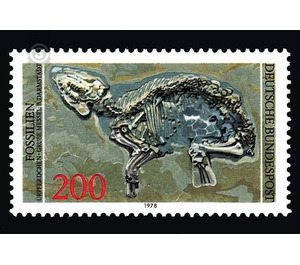Fossils - Germany / Federal Republic of Germany 1978 - 200 Pfennig
Theme: Geology & Geography
| Country | Germany / Federal Republic of Germany |
| Issue Date | 1978 |
| Face Value | 200.00 |
| Color | grey green |
| Perforation | K 14 |
| Printing Type | Six-color offset printing |
| Stamp Type | Postage stamp |
| Item Type | Stamp |
| Chronological Issue Number | 864 |
| Chronological Chapter | GER-BRD |
| SID | 233455 |
| In 34 Wishlists | |
The series »Archaeological Cultural Property« is followed by the special postage stamp issue »Fossils«. The scientifically most significant and most valuable find of the 1975 excavation campaign of the Frankfurt Senckenberg Institute in the Messel pit near Darmstadt was the almost complete skeleton of a roughly 50 million year old prehistoric horse. Almost fully grown, this horse is only 50 cm long. The hull is heavily curved. The front extremities carry four, the hind extremities each three hooves. The molars are still low-crowned and simple. The Messeler Urpferdchen belongs to an early European branch of horse development, which has essentially taken place in North America. A whole series of more or less complete skeletal finds documented in a continuous chronological order the continuous development to today's equinidae with its highly complicated high-crown molar teeth. The phylogenetic development tendencies are therefore quite well known in this case. Until recently, however, the causes of this course of development were unknown. Although more than 100 years ago, the well-known Russian vertebrate paleontologist WOLDEMAR KOVALEVSKY had suggested that the evolution of horses might be related to a change in the environment and lifestyle of deciduous forest dwellers to grass-eating steppe / savanna animals, however This was nothing more than a vague guess. In Senckenberg's Urpferdchen Fund of 1975 stomach contents is preserved. This was the first opportunity to directly review the KOVALEVSKY hypothesis. The result: The stomach contents consist of a package of finely chewed leaves and petals together with some pollen. Thus, the basic correctness of KOVALEVSKY's hypothesis has been proven, at least in one particular case. (Text: Senckenbergische Naturforschende Gesellschaft, Frankfurt am Main)


